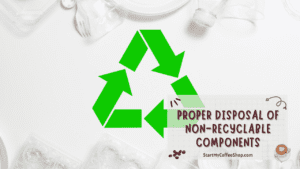Coffee pods have become extremely popular due to their convenience and ease of usage. However, the rising popularity of these single-use pods has generated worries about their environmental impact. Fortunately, you can play an important role in lowering this environmental load by responsibly recycling coffee pods.
To recycle coffee pods responsibly, you should start by rinsing them to remove any residual coffee. Then, carefully separate the components, like the coffee grounds, filter, and plastic. Check if your local recycling program accepts the plastic parts and dispose of the remaining components properly to minimize environmental impact.
In this article, we will walk you through the process of recycling coffee pods to reduce their environmental impact.
Rinse the Coffee Pods

Coffee pods must be completely rinsed before being recycled, which is an essential step in the proper disposal procedure. The inner and exterior surfaces of the pod should be thoroughly cleaned to get rid of any remaining coffee or coffee grounds. Hold the pod under running water and let it flow through it to remove any leftovers.
The benefits of thorough rinsing are numerous. In the beginning, it aids in avoiding potential contamination in the recycling stream. Coffee residues can cause issues during recycling and degrade the quality of recovered materials when they combine with other recyclable elements. Second, the entire recycling process is made more effective and efficient by making sure the pods are clean before recycling. For recycling facilities, clean coffee pods are simpler to handle and process, streamlining their operations and encouraging better recycling rates.
Read more about: Cost to Run a Coffee Shop: Caffeine and Cash
Separate the Components
Your coffee pods should be rinsed first, and then they should be gently disassembled to separate the various parts. Coffee grinds, a filter, and a plastic capsule make up the three primary components of coffee pods. Even while the disassembly procedure is typically simple, it can change based on the kind of coffee pod you use.
Some coffee pods feature distinctive tabs or markings that make it simple to disassemble them. In these situations, carefully follow the packaging directions to separate the components. However, some pods could take a little more work to utilize, and not all have user-friendly designs.
Less user-friendly pods require more time and care to disassemble. Start by locating any readily apparent seams or entry points on the pod’s exterior. To carefully pry open the pod without breaking it, you might need to use a small knife, scissors, or other tool. Make sure the parts separate cleanly by taking your time and using light pressure.
Once the coffee pods have been dismantled, separate the coffee grounds, filter, and plastic capsule for proper disposal or recycling. The filter and plastic capsule must be recycled or disposed of appropriately by your local recycling regulations, while the coffee grounds can be composted or utilized in other environmentally friendly ways.
Deal with the Coffee Grounds
Never undervalue the value of keeping your coffee grounds separate from your coffee pods; even before recycling, they may be useful. Coffee grinds are a great addition to compost piles because they provide vital nutrients to the soil and help it retain moisture. Consider composting them to give them a new life rather than throwing them away.
Coffee grounds are simple to add to the compost if you have a home composting system. Put the grounds and other compostable items, like vegetable scraps and yard trash, in your compost bin. Coffee grounds make an excellent natural fertilizer for plants because as they decompose, they release nitrogen, potassium, and other nutrients that enrich the compost.
Don’t worry if you don’t have a home composting setup. Locals’ used coffee grounds are gratefully accepted by several community gardens and composting facilities. See whether any waste management facilities, farmers’ markets, or community gardens in the area have a program in place for collecting coffee grounds.
Recycling the Filter
Because coffee pod filters are often made of paper, there is a possibility that they can be recycled in certain areas of the world. Find out whether or not the paper filters used in your community’s recycling program are accepted by contacting the facility that manages your waste or visiting the website of the organization that manages your community’s recycling program. If paper filters are allowed, you will have the opportunity to make a little but substantial adjustment to the way that coffee pods are recycled.
After you have removed the coffee pods, you should collect the used filters once you have confirmed that paper coffee filters may be recycled where you live. Before recycling, check to see that the filters are free of any additional contaminants, such as plastic or grounds from previously used coffee. Shake or tap the mugs lightly for a few seconds to get rid of any coffee that may have been left behind. After that, any components that are unable to be recycled should be disposed of appropriately.
After they have been cleaned and separated from the other things, place the filters in the container or bin designated for recycling paper. If you are unsure of the specific requirements for recycling, you might want to consider placing the paper filters inside a paper bag before recycling them. Because of this, loose filters that have been misplaced or lost will not be collected together with the other recyclables.
Recycling the Plastic Capsule
When it comes to recycling, the most significant barrier to be overcome is the plastic capsule that is typically found in coffee pods. This is because not all recycling programs can process this type of plastic. It is also possible for the plastic content to differ between different brands of coffee pods, which makes it more challenging to recycle these products. To effectively address this matter, it is essential to educate oneself on the recycling policies of one’s town as well as the types of plastic that are considered acceptable.
To get started, you should determine whether or not the specific type of plastic that is used in your coffee pods can be recycled at the waste management facility or recycling program in your area. Check the packaging for the pods to see if there are any details or symbols that can be used to determine the sort of plastic that was used. You now know to make an informed decision about whether you want to continue recycling coffee pods as you have in the past or investigate other possibilities.
Don’t give up if the recycling program in your city doesn’t accept coffee pods. There are likely other ways to recycle them. Several companies that produce coffee as well as others that specialize in recycling materials have begun operating collection and recycling programs for used coffee pods. Coffee pods will no longer be thrown away in landfills thanks to the efforts of these programs; instead, they will be recycled properly. Through doing some research on the internet, you may determine whether or not any of these initiatives are available in your region.
Proper Disposal of Non-Recyclable Components

Responsible disposal becomes essential if some parts of your coffee pods cannot be recycled in your location. The environment can be negatively impacted by improperly disposing of non-recyclable parts, thus it’s important to know and use the right disposal techniques.
To find out the proper way to handle non-recyclable coffee pod components, start by contacting your local municipality or waste disposal facility. For the proper disposal of things like plastic capsules or any other non-recyclable materials, they might have certain rules.
Searching for specialist plastic trash disposal programs is one alternative for non-recyclable plastic components. There are drop-off spots and collection points in some places where you can get rid of plastics that are only sometimes accepted by recycling programs.
The waste management agency in your community might offer detailed instructions on how to prepare the non-recyclable parts for disposal. This could entail separating them from other rubbish or putting them in special bins.
To avoid having non-recyclable coffee pod parts end up in landfills or damaging the environment, care must be taken when handling them. Particularly plastics can take hundreds of years to disintegrate, which releases dangerous chemicals and adds to the expanding issue of plastic pollution.
As a responsible consumer, think about finding ways to avoid using single-use coffee pods altogether. Choose more environmentally friendly options that produce less waste, such as conventional brewing techniques or reusable coffee capsules.
Read more about: Cost to Start a Coffee Shop: The Financial Blueprint
Consider Using Reusable Coffee Pods
The convenience and simplicity of using coffee pods have contributed to their meteoric rise in popularity over the past several years. However, growing worries regarding the impact they have on the environment have been brought up as a result of their extensive use. Switching to coffee pods that may be used more than once is one of the most practical and environmentally conscious things you can do to reduce the severity of this impact.
Reusable coffee pods are constructed from long-lasting materials such as stainless steel or silicone. They are built to withstand several uses without degrading the quality of the coffee inside of them. You can effortlessly fill these pods with any ground coffee of your choosing, giving you a wide variety of alternatives and guaranteeing that your experience with coffee is unique to you.
The use of coffee pods that may be reused confers significant positive impacts on the environment. The traditional, one-time-use coffee pods, which are often constructed from a combination of plastic and aluminum, are a substantial contributor to the issue of excessive global waste. Because of the ease of use, they provide, people frequently adopt a “use and throw away” mentality, which results in the generation of tons of non-biodegradable garbage that is deposited in landfills or litters our natural habitats. Individuals may substantially minimize the amount of garbage they contribute to by using reusable pods, which is a huge step towards making the planet greener and cleaner overall.
In addition to lowering the amount of waste produced, reusable coffee pods offer financial benefits. Although it may be more expensive to make an initial investment in a reusable pod as opposed to purchasing one that is disposable, the cost savings over time are substantial. Because customers may buy coffee in large quantities and fill the pods on their own, this reduces the requirement for individually packed pods, which are typically more expensive. Because of this, it is possible to accumulate significant cost savings over time, making it a prudent choice from a financial perspective for people who are passionate about coffee.
The use of reusable pods enables coffee enthusiasts to live a lifestyle that is more environmentally friendly and sustainable. Individuals can take additional steps toward eco-friendly behaviors in other aspects of their lives if they are actively involved in the process of brewing their coffee, as this makes them more conscious of the influence their activities have on the environment and motivates them to take action.
Frequently Asked Questions

Can I recycle coffee pods in the same bin as my other recyclables?
The recycling program in your area will determine this. While some recycling facilities do not take plastic coffee pods, others do. Ask your neighborhood waste management or recycling facility if they take coffee pods before putting them in your usual recycling bin. If not, research reusable coffee pod choices or alternate recycling schemes to reduce waste.
How can I determine whether the coffee pods’ plastic is recyclable?
It can be difficult to determine whether coffee pod plastics can be recycled because different manufacturers may use different kinds of plastic. On the bottom or side of the pods, look for any recycling symbols or numbers that denote the kind of plastic used. Then, you can compare this data to your community’s recycling regulations or ask your waste management facility if they accept a certain kind of plastic.
Are coffee pods with coffee grounds inside compostable?
Coffee pods with coffee grounds inside should rarely be composted. While coffee grinds are great for composting, coffee pods’ plastic and other elements are not compatible with the process. Coffee grounds can be composted by removing them from the pod and placing them in your compost bin or visiting a nearby facility that accepts them. Recycling or trash management will ensure a more environmentally responsible method of disposal for the leftover parts.
To learn more on how to start your own coffee shop, check out my startup documents here.
Disclaimer: The information provided by StartMyCoffeeShop.com (“The Site”) is for general informational purposes only. All information on the Site is provided in good faith. However, we make no representation or warranty of any kind, express or implied, regarding the accuracy, adequacy, validity, reliability, availability, or completeness of any information on the Site. Under no circumstance shall we have any liability to you for any loss or damage of any kind incurred as a result of the use of the Site or Reliance on any information provided on the Site. Your use of the Site and reliance on any information on the Site is solely at your own risk. This blog post is for educational purposes only and does not constitute legal advice. Please consult a legal expert to address your specific needs. Terms and Conditions. (https://startmycoffeeshop.com/terms-and-conditions/)

Hi! I’m Shawn Chun
My adventure in coffee began when I first launched my first coffee shop back in the early 2000s. I had to figure out so many things on my own and to make it worse within 2 years of opening two large corporate coffee chains moved in just blocks away from me!
As I saw smaller and even some larger coffee shops in the neighborhood slowly lose customers to these giant coffee chains and slowly close up shop, I knew that I had to start getting creative…or go out of business.
I (like you may be) knew the coffee industry well. I could make the best latte art around and the foam on my caps was the fluffiest you have ever seen. I even had the best state-of-the-art 2 group digital Nuova Simonelli machine money could buy. But I knew that these things alone would not be enough to lure customers away from the name brand established coffee shops.
Eventually, through lots of trial and error as well as perseverance and creativity I did find a way to not only survive but also thrive in the coffee/espresso industry even while those corporate coffee chains stayed put. During those years I learned to adapt and always faced new challenges. It was not always easy, however, in the end, I was the sole survivor independent coffee shop within a 10-mile radius of my location. Just two corporate coffee chains and I were left after that year. All told the corporate coffee chains took down over 15 small independent coffee shops and kiosks and I was the last one standing and thriving.
Along the years I meet others with the same passion for coffee and I quickly learned that it is not only “how good a barista is” that makes a coffee shop successful, but the business side of coffee as well.
Hence why I started this website you are on now. To provide the tools and resources for up and coming coffee shop owners to gain that vital insight and knowledge on how to start a coffee shop successfully.
Stick around, browse through my helpful blog and resources and enjoy your stay! With lots of LATTE LOVE!
Shawn







